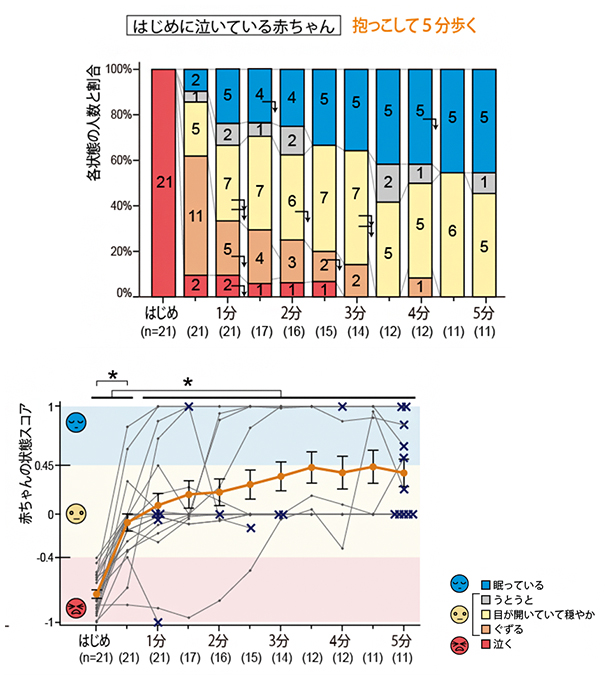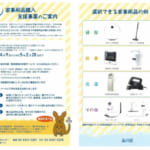- The following is content from the press release -
Please note that many of the press releases presented on this site are merely reports of the latest experiments, analyses, and other results from papers. Details
An international research group led by Nami Omura and Kimi Kuroda, team leaders of the Affinity Social Behavior Research Team at the RIKEN Brain Science Institute (RIKEN), has discovered scientifically based tips to help babies stop crying and sleep.
The results of this research are expected to help reduce the stress of caregivers who are troubled by crying babies and to prevent abuse.
In 2013, Kimi Kuroda and her colleagues discovered a "transport response[1]" in mice and humans in which parents become docile when they carry their babies. However, this study had two problems: the duration of carrying was only about 20 seconds, and when the carrying was stopped, the baby would cry again.
This time, the international research group found that when a baby is crying, if a mother carries the baby in her arms and walks around for 5 minutes continuously, not only does the baby stop crying, but about half of the babies fall asleep. They also found that when placing a baby in bed after sleeping in the arms of a parent, the baby is more likely to wake up when the body is separated from the parent, and some babies wake up after being placed in bed, but by sitting up from the beginning of sleep and waiting 5 to 8 minutes before placing the baby in bed, the baby is less likely to wake up. However, by waiting 5-8 minutes from the beginning of sleep before placing the baby in bed, the baby is less likely to wake.
The study was published in the online edition of the scientific journal Current Biology on September 13 (Sept. 14, 2012, Japan time).

background
It is normal for babies to cry a lot, as it is said that crying is their job. However, too much crying and not falling asleep can be stressful for parents and, in rare cases, can even lead to abuse. Different cultures have used different methods to put babies to sleep, such as piggybacking, carrying, stroller walks, cradling, and swaddling (wrapping the baby in a cloth). Surprisingly few studies have scientifically tested the effectiveness of these methods, however, and it is not well understood how to effectively get babies to stop crying and fall asleep, other than through drugs.
In 2013, team leader Kimi Kuroda and his colleagues discovered a phenomenon in which parents cry less and become more docile when they walk with their babies in their arms, and reported it as the "transport responseNote 1). The transport response is observed not only in human babies but also in other mammals such as mice, cats, and lions. Since parents of wild animals often carry their offspring in dangerous situations, such as when foreign enemies are approaching, it is thought that the offspring also cooperate with the parents so that they can be carried easily without getting out of control or making a fussNote 2). However, the research at that time only examined the effects of short transports of about 20 seconds, and even if the crying decreased when the parent carried the child and walked, the baby would immediately start crying again when the parent stopped walking. The current study therefore looked at the effects of longer transports and different methods of transport on babies' crying and physiological indicators.
(Note 1) April 19, 2013 press release, "Part of how babies relax when they walk around in a carrier."
(Note 2) Yoshida S, Esposito G, Ohnishi R, Tsuneoka Y, Okabe S, Kikusui T, Kato T, Kuroda KO. Transport Response is a filial-specific behavioral response to Front Zool. 2013 Aug 14;10(1):50. DOI: 10.1186/1742-9994-10-50.
Research Methodology and Results
With the cooperation of 21 babies under 7 months of age and their mothers, the international research group asked them to randomly perform four tasks that combined movement and carrying: walking with the baby carried, sitting with the baby carried, placing the baby in bed, and moving the baby back and forth in a stroller (Figure 1A), and the baby's condition and electrocardiogram were recorded during these tasks.
First, we analyzed the condition of the babies during 30 seconds of each task, based on their voices and eye opening and closing. We found that babies who had been crying intensely significantly stopped crying when they were carried and walked or moved back and forth in a stroller, but not when they were held in a sitting position (Figure 1B). Babies who were quiet or slightly fidgety did not change when they were moving, such as walking with their arms or moving the stroller, but rather tended to cry more when they were not moving, such as being carried in a sitting position or placed on a bed (Fig. 1C). This indicates that transportation is effective in stopping babies' crying.

A) Four tasks performed in the experiment.
B) Changes in state scores at the beginning and 30 seconds after the four tasks were performed on the crying baby. p<0.05, p<0.001.
C) Changes in state scores at the beginning and after 30 seconds when the four tasks were performed on a baby who was awake without crying. *P<0.01, P<0.001.
Next, when the babies who had been crying heavily were given 5 minutes of cuddle walking, which was the most effective 30-second task, all stopped crying and 45.5% fell asleep (Figure 2). Additionally, 18.2% of the babies were awake when they stopped walking, but fell asleep within the next minute. Thus, walking for 5 minutes while carrying a baby was not only highly effective in stopping the baby's crying, but also put about half of the babies to sleep even during the day.

Changes in the number and percentage of participants in each state (top) and state score (bottom). Cases in which the task was interrupted due to parental fatigue or experimental considerations are indicated by (↴) (x). *P<0.05.
On the other hand, the baby who was awake without crying at first hardly fell asleep even after being carried and walked for 5 minutes (Figure 3). The reason for this is unknown, but it is possible that the crying babies were originally tired or sleepy and groggy, and were easier to put to sleep by transportation than the babies who were awake and healthy.

Changes in the number and percentage of people in each state (top) and state score (bottom) when a baby was held and walked for 5 minutes while awake without crying. Cases in which the task was interrupted due to parental fatigue or experimental considerations are indicated by (↴) (x).
Even after a baby falls asleep after being swaddled and walked, the baby still faces the challenge of waking up when placed in bed. In this study, about one-third of the babies woke up when placed in bed after they had fallen asleep.
Therefore, we analyzed electrocardiograms to examine the baby's condition more precisely. Changes in a baby's heart rate sensitively reflect the state of activity of the autonomic nerves that control sleep and wakefulness. When the heart rate interval[2] is large (= slow heart rate), the baby is in a relaxed state with parasympathetic dominance among the autonomic nerves, and when the heart rate interval is small (= fast heart rate), the baby is in an excited or stressed state with sympathetic dominance.
Analysis of this heart rate change revealed that two-thirds of the babies who were put to bed from being carried while asleep and who continued to sleep fell into an even deeper sleep after being placed in bed than when they were carried (Figure 4A). However, even these apparently well-slept babies, like those who had been awakened, showed a faster heart rate and a change toward arousal when they were placed in bed. And the timing at which this arousal began was not when their backs reached the bed, but earlier, when their swaddled bodies began to move away from their parents (Figure 4B, C). In Japan, the phenomenon of a sleeping baby waking up when placed on the bed is called the "back switch," but the switch was actually on the baby's "belly" (the surface in contact with the parent).
We also found that sleeping babies are acutely responsive and their heart beats faster even when their parents change the direction they are facing when walking to carry them, when a sitting parent changes the position of the hand on the baby, or when a parent touches a sleeping baby on the bed. In other words, babies are constantly sensing and reacting to changes in their parents' behavior, even when they are sleeping.
Finally, to clarify how to place a sleeping baby in bed without waking him or her, we examined whether there were any differences in the way the parents placed the baby in bed in the group in which the baby woke up and in the group in which the baby continued to sleep. We examined in detail to see if there were differences in the speed at which the parents placed the baby's body and which part of the body was placed first, but there were no differences between the two groups.
The only distinct difference between the two groups was the length of time the babies were asleep before they were placed in bed (Figure 4D). Babies who woke up were placed in bed an average of 3 minutes after they had fallen asleep, while those who continued to sleep were placed in bed an average of 8 minutes after they had fallen asleep. Even for babies who had continued to sleep, we also found that if they were placed within 5 minutes of falling asleep, they were very close to waking up, opening their eyes or making noises during the placement process. In fact, sleep research has shown that the sleep immediately after falling asleep is called "stage 1 sleep," in which sleep is still shallow and even the slightest noise can wake the baby. The average length of this stage 1 sleep was about 8 minutes for babies. This suggests that if you wait 5 to 8 minutes after your baby begins to sleep, he or she is less likely to wake up because he or she has entered a deeper stage of sleep.

A) Heart rate intervals of a baby sleeping in a swaddled position and a baby sleeping in bed. The baby placed in bed has a larger heart rate interval and sleeps more deeply. **P<0.01.
B, C) When a sleeping baby is placed in bed, the heart rate interval drops in the direction of arousal as the body begins to move away (B). When part of the body lands on the bed, the heart rate interval is already low (C).
C) Percentage of time between when the baby fell asleep and when it was put to bed and the time it awoke between when it was put to bed and 40 seconds after it was put to bed. Blue: child who continued to sleep after being put to bed. Pink: A child who woke up when placed on the bed. Blue/pink solid line: mean ± SEM of time from falling asleep to placing; blue/pink dotted line: mean ± SEM of percentage of time awake up to 40 seconds after placing; P<0.01, *P<0.001.
To summarize these results, we found that when a baby is crying, if you carry the baby and walk at a steady pace for 5 minutes as much as possible, and then, even if the baby falls asleep, do not put the baby directly to bed, but sit with the baby in your arms and wait for 5 to 8 minutes before putting the baby to bed, the baby is likely to sleep more deeply without waking up. This is more likely to allow the baby to sleep more deeply without waking up.
Future Expectations
There are many suggestions to help with the problem of babies falling asleep and crying at night, including improving daily habits such as setting a bedtime routine and letting them play well during the day, and training babies to fall asleep on their own. However, less is known about what can be done at the very moment when nighttime crying is occurring. Even if you try to calm him down by feeding him, his mother may not be there, or he may not even accept milk or a pacifier when he is crying so hard.
This study demonstrates the effectiveness of "cuddle walking" which can be used in such situations and is effective in a few minutes. The walking area should be on a flat surface with no objects to trip over. You can carry your baby by hand or use a baby carrier or piggyback strap, but be sure to support the baby's body and head on your own body to prevent wobbling. Walking at a steady pace for about five minutes, without turning around abruptly or stopping unnecessarily, is effective in calming the baby's heartbeat and encouraging crying to stop. And if the baby you are carrying falls asleep during this five-minute transport, sit and wait for five to eight minutes before placing him or her on the bed. This study also found that if they are sleeping well before you put them down, they will go back to sleep even if they are slightly awakened when your body leaves them.
Walking with a baby in your arms for about 5 minutes can be done safely with general precautions, as you will experience this in your daily life, such as taking your baby for checkups, shopping, and so on. If the baby does not stop crying after 5 to 10 minutes of walking, it is recommended to observe the baby for any unusual behavior. For example, if the baby is crying because he or she is sick, such as with otitis media, it is unlikely that the crying will stop with transport. On the other hand, it is also known that babies' crying varies greatly from person to person, and if there is no particular medical problem after consulting a medical institution, the amount of crying itself is not considered to affect subsequent development.
Some cultures believe that soothing babies by holding them when they cry is important for their peaceful upbringing, while others believe that it spoils them by preventing them from crying themselves to sleep and developing the ability to sleep. We do not know about these long-term effects, as we did not examine them in this study, but further scientific research is needed to find out what they actually are.
In addition, while the five-minute transports examined in this study have an immediate effect on getting a crying baby to stop crying now, they are not intended to replace usual childcare methods, such as adjusting the baby's rhythm of life and environment to make it easier for the baby to fall asleep. Rather, this method may be more useful in unusual situations, such as travel or parental absence, where the baby is sleepy but groggy and unable to fall asleep, rather than as a daily bedtime routine.
Furthermore, although this experiment was conducted with mothers, we believe that it is also effective with people other than mothers, as fathers, grandparents, babysitters, etc. may also carry their children to sleep in their arms or in a stroller. We would like to verify in the future whether the effect differs from person to person.
supplementary explanation
- transport reaction
An innate response in mammalian babies that makes them docile when being carried. When being carried, the baby cries less, becomes sedated, and enters a parasympathetically dominant state. In quadrupeds, they often assume a compact posture. It is thought to be a response to cooperate with the parent in carrying the offspring so that it can be carried safely and smoothly. - heart rate interval
The time interval between heartbeats (in milliseconds). Heart rate is the number of beats per minute and is the reciprocal of the heartbeat interval. In the normal heart, the heartbeat interval is not always constant, but fluctuates and fluctuates. Various biological functions, including respiration, blood pressure, and the autonomic nervous system, are involved in the control of the heartbeat interval.
International Collaborative Research Group
Affinity Social Behavior Research Team, RIKEN Center for Brain Science and Neurobiology
Kimi Kuroda, Team Leader
Researcher Nami Omura (Tagane)
Technical Staff II (at the time of the study) Rana Okuma
(Currently Technical Staff II, Human Cognition and Learning Research Team)
Kazutaka Shinozuka, Researcher
Technical Staff Ⅱ Eri Miyazawa
University of Trento, Italy
Professor Gianluca Esposito
Graduate Student (at time of research) AnnaTruzzi
(currently Research Fellow, Trinity College, University of Dublin)
Assistant Professor Andrea Bizzego, Ph.
Department of Psychology, Faculty of Integrated Human Sciences, Sophia University
Associate Professor Jiko Saito
Saitama Cardiovascular and Respiratory Disease Center, Department of Laboratory Technology
Susumu Yokota, Deputy Director
Saitama Children's Medical Center Comprehensive Perinatal Maternal and Child Health Center
Director of the Center Masaki Shimizu, Chief of the Department of Neonatology
Research Support
This work was supported by JSPS Grants-in-Aid for Scientific Research (B) 24730563 (PI: Gianluca Esposito), 16K21617 (PI: Nami Omura), 19K17074 (PI: Nami Omura), 18KT0036 (PI: Kimi Kuroda), and the Japan Science and Technology Agency (JST) Research and Development of Social Technology JPMJRX18B1 (PI: Kimi Kuroda).
precautions
RIKEN does not guarantee the certainty or safety of the use of the results of this research. RIKEN shall not be liable for any loss or damage arising from the use of the results of this research.
Original Paper Information
Nami Ohmura, Lana Okuma, Anna Truzzi, Kazutaka Shinozuka, Atsuko Saito, Susumu Yokota, Andrea Bizzego, Eri Miyazawa, Masaki Shimizu, Gianluca Esposito, Kumi O. Kuroda, "A method to soothe and promote sleep in crying infants utilizing the Transport Response", Current Biology, 10.1016/j.cub.2022.08.041
announcer
RIKEN
Affiliative Social Behavior Research Team, Neuroscience Research Center
Kimi Kuroda, Team Leader
Researcher Nami Omura (Tagane)















An international joint research team led by the RIKEN Neuroscience Research Center has discovered scientifically based tips for stopping babies' crying and putting them to sleep. While I believe that this is something that I have been experiencing by feel if you ask me, the fact that it has been scientifically backed up is expected to be applied in the future in the field of baby tech and the concerns of parents caregivers.
Let's take a look at the details from the press release.